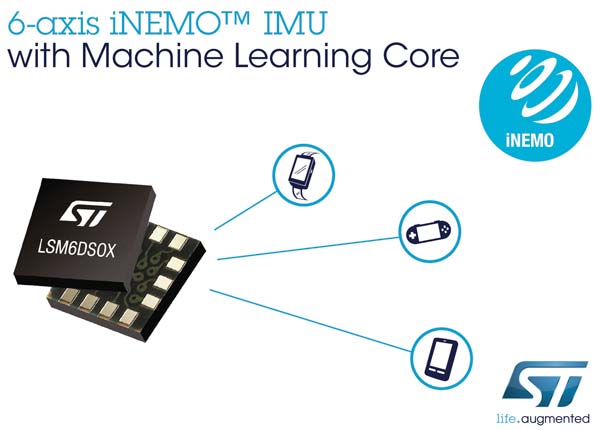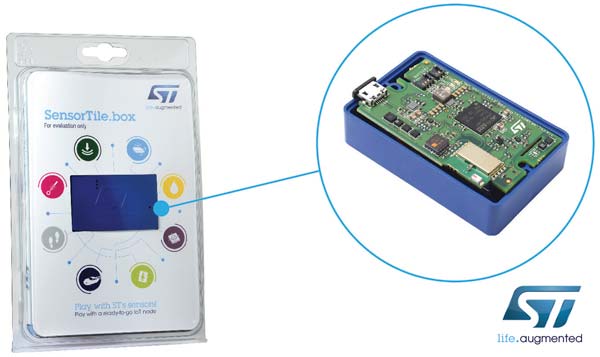Inertial measurement units comprising an acceleration sensor and gyroscope have gained widespread acceptance in applications for capturing movements, determining spatial orientation as well as stabilizing images and objects. To reduce power consumption and to improve the quality of data capture, ST has integrated machine-learning technologies into its latest sensor.
Up to now, reducing the power consumption of inertial measurement units (IMUs) has been an unsolved dilemma. That is because it involves either sending vast quantities of captured raw data – an energy-intensive process – or pre-processing this data in the host microcontroller, an operation that is no less power-hungry.
With the new MEMS sensor LSM6DSOX from the iNEMO family, ST has provided an elegant solution to this ‘Gordian knot’: Here, a machine-learning core works with finite-state machines (FSMs) and classifies motion data based on known patterns along a decision tree. As a result, the main processor no longer needs to perform this first level of activity tracking. The result? Power consumption is reduced while at the same time detection is improved, which increases the processing speed of apps such as fitness trackers, apps for wellness monitoring, navigation or the fall detection function in smartphones, wearables or game controllers.
Decision-tree logic for quick and efficient processing
A decision tree is a tool that supports mathematical differentiations. It consists of multiple configurable nodes. At each node, a statistical parameter is compared with a threshold value and the next node is selected based on the result. If this ultimately reaches a leaf – one of the last nodes of a tree – the decision tree generates a result that can be read by a specific device register.
With the help of the decision tree, the sensor processes an inductive algorithm with a fraction of the normal power consumption. The system can not only detect movements such as walking, running, jogging, cycling or immobility, but can even count bicep curls, squats, push-ups and other movements during a workout, for example – all on the basis of learned patterns.
The choice of data is critical in order to achieve a highly accurate result: Data that characterizes the required class of a movement must be collected. Since it is highly complex to describe these classes manually in software, machine learning tools are used here, which greatly simplify the programming. ST uses the publicly available machine learning tool “Weka” and a dedicated development environment that converts the acquired parameters into register settings of the sensor. This means that the developer can simply concentrate on the functionality without first having to evaluate the collected data.
The LSM6DSOX can be configured to process up to eight decision trees simultaneously and independently of one another.
Programmable interrupts
In addition, the LSM6DSOX can issue an interrupt for specific user-defined movements. For this purpose, the finite-state machines can be independently programmed for specific motion detection types, such as a glance at a display, a turn of the wrist, a shake, double shake or picking up the device. Each of the 16 finite-state machines has its own memory area and is executed independently from the others. The interrupt is triggered once the final movement state has been reached. Other configurable functions are predefined to trigger interrupts for free falls, motion detection, 6D/4D orientation as well as clicks and double-clicks.
The LSM6DSOX can also be used for closed-loop control applications, for example, for stabilizing moving industrial controllers. Special cases of this application are optical and electronic image stabilization (OIS and EIS) in camera systems. These functions are supported by an additional auxiliary SPI output that provides data without routing it via FIFO registers, thus guaranteeing rapid reaction times of the duration required, for example, in optical image stabilization.
Always-on user experience with low power consumption
The LSM6DSOX is a System-in-Package (SiP) with a combined mechanical 3D acceleration sensor and 3D gyroscope together with a low-power CMOS-ASIC for evaluation in a small plastic land-grid array enclosure (LGA-14L). Its acceleration range of ±2/4/8/16g and the angular rate range of ±125/250/500/1000/2000 dps are dynamically selectable. The high-performance mode ensures high performance at a power consumption of just 0.55 mA. With its extremely low-noise acceleration sensor and gyroscope, the sensor combines an always-on user experience with low energy consumption and outstanding measuring accuracy. The sensor hub can also be used to connect an external sensor, e.g., a magnetometer.
With all of these features, the LSM6DSOX opens up a vast spectrum of applications – not only for motion detection but also for managing user interfaces, protecting laptops, detecting motion patterns and vibration for robots, machine controllers and forklift trucks all the way to the detection of aircraft movements such as take-offs and landings.
| Part number | Description |
| STEVAL-MKI197V1 | LSM6DSOX adapter board for a standard DIL24 socket |
| X-NUCLEO-IKS01A2 | Motion MEMS and environmental sensor expansion board for STM32 Nucleo |
| STEVAL-MKI109V3 | Professional MEMS tools board |
| STEVAL-MKSBOX1V1 | Ready-to-use box kit with wireless IoT and wearable sensor platform to help customers use and develop apps based on remote motion and environmental sensor data, regardless of the level of expertise. |
Authors: Maria Alejandra Salazar Martinez, Product Sales Manager Analog & Sensors at Rutronik, and Werner Neumann, Technical Marketing at STMicroelectronics





